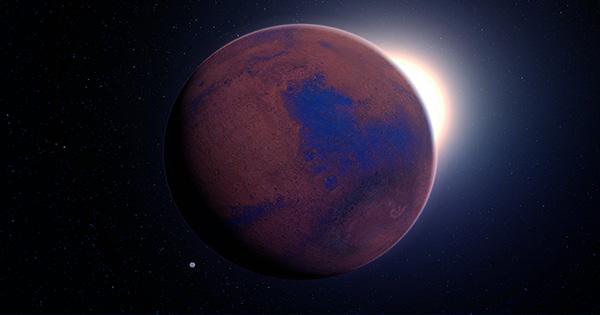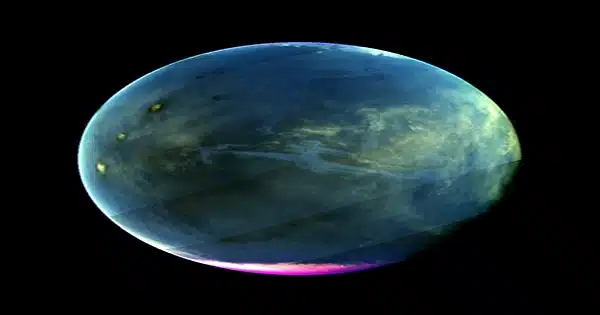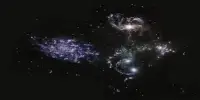The MAVEN (Mars Atmosphere and Volatile EvolutioN) mission of NASA captured spectacular views of Mars in two ultraviolet photos obtained at various places along Mars’ orbit around the Sun.
Scientists can obtain great insight into the Martian atmosphere and surface features by studying the planet in ultraviolet wavelengths.
These global images of Mars were captured by MAVEN’s Imaging Ultraviolet Spectrograph (IUVS) instrument in 2022 and 2023 when the planet was approaching the opposite ends of its elliptical orbit.
Outside of the visible spectrum, the IUVS device measures wavelengths between 110 and 340 nanometers. The photos are generated with the different brightness levels of three UV wavelength ranges depicted as red, green, and blue to make these wavelengths visible to the human eye and easier to interpret. Atmospheric ozone looks purple in this color scheme, whereas clouds and haze seem white or blue. Depending on how the photos have been edited to boost contrast and display detail, the surface can appear tan or green.

The first photograph was taken in July 2022, during the summer season in the southern hemisphere, when Mars is closest to the Sun. The summer season, like seasons on Earth, is caused by the tilt of the planet’s rotational axis. At the bottom left, Argyre Basin, one of Mars’ deepest craters, is filled with air haze (seen here in pale pink). At the top left, the deep canyons of Valles Marineris are loaded with clouds (colored tan in this view). The southern polar ice cover, shown in white at the bottom, is receding due to the relative warmth of summer. Warming and dust storms in the southern summer send water vapor to very high altitudes, explaining MAVEN’s discovery of increased hydrogen loss from Mars at this time of year.
The second image is of Mars’ northern hemisphere, and it was obtained in January 2023, after Mars had crossed the point in its orbit where it was the furthest away from the Sun. White clouds are abundant in the north-polar region due to the fast-changing seasons. The deep canyons of Valles Marineris, as well as numerous craters, may be seen in the lower left. Ozone, which appears magenta in this UV picture, has accumulated throughout the cold frigid nights of the northern winter. It is then eliminated in northern spring by chemical interactions with water vapor, which at this time of year is restricted to low altitudes of the sky.
MAVEN was launched in November 2013 and arrived in orbit around Mars in September 2014. The purpose of the mission is to investigate the planet’s upper atmosphere, ionosphere, and interactions with the Sun and solar wind in order to investigate the loss of the Martian atmosphere to space. Understanding atmospheric loss provides scientists with information about Mars’ atmosphere and climate, liquid water, and planetary habitability. In September 2024, the MAVEN team will commemorate the spacecraft’s tenth year on Mars.
MAVEN’s primary investigator is based at the University of California, Berkeley, and the mission is managed by NASA’s Goddard Space Flight Center in Greenbelt, Maryland. The spacecraft was built by Lockheed Martin Space, which is also in charge of mission operations. Navigation and Deep Space Network support are provided by NASA’s Jet Propulsion Laboratory in Southern California. The University of Colorado Boulder’s Laboratory for Atmospheric and Space Physics is in charge of science operations as well as public outreach and communications.















